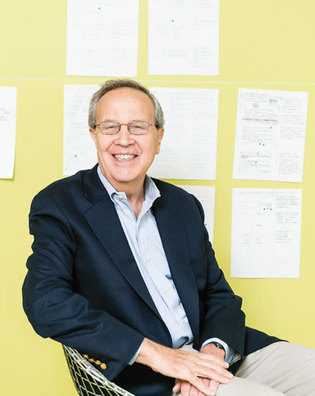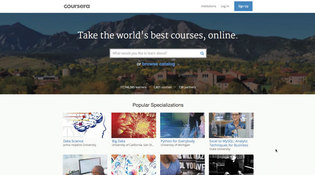
Courtesy Coursera
Rick Levin, who spent 44 years at Yale as a graduate student, professor, and ultimately the university’s president, found himself on the floor of a Silicon Valley office building one fall day, doing push-ups.
The occasion was an all-hands meeting at Coursera, the online education company where Levin ’74PhD is now CEO. An executive thought the firm held too many meetings, and suggested that everyone in the room do ten push-ups to discourage the practice. Levin looked around with an is-this-really-happening gaze, watched as his employees dropped down to the ground, and then joined them for the brief workout.
Welcome to California.
This is not the land of Woodbridge Hall, the Beaux-Arts–style building where Yale’s president works. Levin has traded the wicker rocking chair he favored in New Haven—it once belonged to Ezra Stiles—for a plastic office chair in this open-floor-plan world of venture money and buzzwords.
But lifestyle changes aside, Levin is visibly animated when talking about Coursera’s efforts to put the world’s best courses online. In his new job, he continues to engage with some of his longtime interests, like the future of Asian education, and so far has earned praise from colleagues for his ability to navigate a huge shift in style.
“There’s a lot of reverence for him,” recalls a former Coursera manager, John Ciancutti, “in a culture that’s not reverent.”
And it goes both ways. Levin turns out to have had reverence for Coursera long before he joined the company.
A few months ahead of Levin’s departure from the Yale presidency in the summer of 2013, Emily Nelson ’95 and I interviewed him on stage at an alumni event at the Yale University Art Gallery. He was at the time uncertain about his future, but he predicted that the next decade at Yale would be defined in large measure by the question “How will Yale cope with the online revolution?” He mentioned the “tsunami” of online learning start-ups, led by the nonprofit EdX and the for-profit entrants Udacity and Coursera. They were all founded within six months of each other. He cautioned that it was too soon to tell how the industry would develop, and whether the MOOCs—massive open online courses—that the companies were touting could actually deliver meaningful education.
Levin went on to volunteer that he had real respect for the founders of Coursera, Stanford professors Daphne Koller and Andrew Ng, calling them “visionary and enthusiastic.” He added, “They’re nimble. I would not be surprised if they’re survivors in this game.”
In the fall of 2013, Levin and his wife, Jane, moved to California for a sabbatical from Yale. They knew the area well, having met in a freshman English class at Stanford nearly 50 years earlier, and were also excited about living on the same coast as their four children and seven grandchildren. Levin spent much of his time that semester at the Stanford Institute for Economic Policy Research.
On a trip to New York around the Thanksgiving holiday, Levin attended a gala reception and ran into former vice president Al Gore. Gore, who is a partner at the venture capital firm Kleiner Perkins Caufield and Byers, asked Levin what he was up to and suggested he visit with the leadership at Coursera (which Kleiner is invested in) to discuss how he could help them.

The home page of Coursera's website features "specializations" to encourage students to "develop mastery in a specific subject."
View full image
Out of those initial meetings came the idea that Levin would become a paid adviser to Coursera in January of 2014. He would split time between California and New Haven, where Jane Levin was set to resume teaching her Directed Studies course for the spring semester. Levin said he had “barely started” in this role when John Doerr, the Kleiner partner who leads its investment in Coursera, approached him about becoming the full-time CEO. He officially started the job in April of 2014. At 68, Levin now jokes that he must be the oldest CEO in Silicon Valley.
Coursera has some 120 employees and a bold mission: to “provide universal access to the world’s best education.” The company has enlisted 138 “partner” institutions from all over the world—from the University of Cape Town to Peking University, from the Universidad de los Andes to Copenhagen Business School. About half are US institutions. And not all are universities. The World Bank Group, the Museum of Modern Art, and the National Geographic Society are all Coursera partners. The partners film the lectures and prepare all course materials; Coursera provides the online platform.
While Levin oversees the whole company, part of his portfolio consists of cultivating and maintaining relationships with potential partners in Britain, the United States, and Asia (where he built many connections for Yale when he served as president). The case he makes to these schools is that they and their faculty members can have a bigger impact when they allow their courses to be offered online. “Instead of teaching 20 students in a class, or maybe 200 in a lecture course,” Levin says, “you can teach 20,000 in a session—or 50,000.”
Coursera currently has 1,797 courses available, and many live up to the “massive” in “MOOC.” In late 2015 the New York Times reported that Learning How to Learn, from the University of California–San Diego, was “the world’s most popular online course.” Its cumulative enrollment was then 1,192,697, and it was hardly the only MOOC that had hit the million-students mark.
Robert Shiller, Yale’s Sterling Professor of Economics, is a popular instructor on Coursera and says he’s enjoyed meeting strangers who tell them they have watched his lectures online. Shiller traces the origins of Coursera and MOOCs to the “correspondence courses” that boomed in popularity with the advent of the radio in the 1920s, and to later efforts including Yale’s AllLearn and Open Yale Courses initiatives. “My impression is one of change and improvement,” he says. “The management of these courses keeps getting better, and more effective.”
Levin is so confident in the increasing importance of MOOCs that he wonders aloud if one day the global rankings of universities might take into account the number of views of schools’ online courses offered by a school.
Still, there is an open question as to who is taking the courses and what students are getting out of them. Completion rates for MOOCs are low—less than 10 percent, according to a 2014 review of publicly available data—as you’d expect for anything offered online for free. For a small fee ($20 to $130 at Coursera), a student can receive a certificate for finishing an entire course and completing all quizzes. It’s easy to imagine a certificate being useful for something like a popular computer programming class from the University of Michigan, but harder to imagine it for those enrolling in the course taught by Yale law professor Akhil Reed Amar ’80, ’84JD, on the US Constitution.
Levin says the most popular subject areas on Coursera are fundamental business skills and technology. That makes sense, since some 78 percent of Coursera users are over age 22—mainly people trying to start a new chapter in their career with an additional skill. Of course, Coursera also attracts lifelong learners who are exploring Buddhism, Beethoven, Kierkegaard, or ancient Egypt.
As for Levin, he is clear that while Coursera is his second act, it will not be his last. He says it’ll be “very surprising” if he stays at the company more than a half dozen years. And he clearly still has a passion for national economic policy.
Levin seems comfortable letting go of the deep involvement he had at Yale. He’s back on campus occasionally, especially in the spring when Jane teaches and the two, who have been married for 47 years, go “long distance.” He says he speaks “when spoken to” about university matters.
Levin, reflecting on the differences between Yale and Silicon Valley, in his office just down the street from the Googleplex, says his experience out west has taught him that any organization must move at the speed appropriate to its history and challenges. “In universities, things move very slowly—and at a university like Yale, risk taking can only be done after a lot of consultation,” Levin says. “Here, the pace of things just demands a quicker turnover.”
Maybe that’s why he now wears Nike sneakers to work.
 loading
loading
